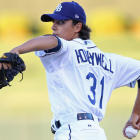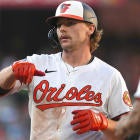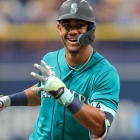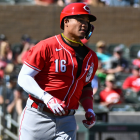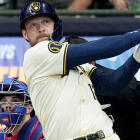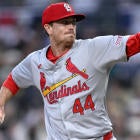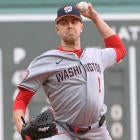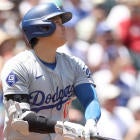Rumors are circulating that the 2020 minor-league season will be canceled. Officially, MLB has denied this, but we don't need official confirmation, do we? It goes without saying, given all the hoops major-league ball will have to jump through to get going again, that minor-league ball, being more expansive and far less lucrative, is going to fall by the wayside. It's been the operating presumption for a while now.
A canceled minor-league season would (or will?) have far-ranging effects, some of which would (or will?) change some of our usual behaviors in Fantasy Baseball.
Let's examine those now.
How could a reduced season and no MiLB effect prospects getting called up?
— Brian Weaver (@BDWeav2) April 30, 2020
I feel like I've gotten some form of this question each of the past three weeks, so apologies to those who've heard it all before. But the situation is ever-evolving, and I of course know better than to think everyone reads every word I write.
So ... my thoughts. Rosters aren't expected to be expanded past 30, so it's not like teams can tote around all of their top prospects, nor would they want to start the service time clock for the ones who obviously aren't ready. No, they'll need another way to prevent some of their top assets from falling into atrophy, and an idea I floated a couple weeks ago that appears to have some traction now is for every organization to have a selection of their best prospects playing unofficial games against each other at their spring training sites.
Of course, that plan becomes less viable if the major-league teams themselves aren't playing at their spring training sites, with all of those extra playing fields, and I'm sure there would be some contractual issues to sort out. But some sort of taxi squad situation to me seems entirely necessary. Not only would it help further the development of those top assets, but it would give organizations a pool of talent to draw from still when they inevitably have to replace someone on the big-league roster. Expanding that roster to 30 will help alleviate the need for some of those transactions, sure, but it wouldn't fully eliminate it.
Since I'm of the belief, then, that such an arrangement will have to exist, I'm not expecting to see the sort of prospect free-for-all that so many others are, where everyone with any hope of joining the 2020 roster will just start out there. I think the prospects that teams are most confident can make an immediate contribution — like the White Sox's Nick Madrigal and the Blue Jays' Nate Pearson — probably will, but teams will remain as reluctant as ever to promote the ones that are still in need as development, not wanting to commit a full year of service time or create an unconventional demotion situation that then requires them to call up another not-quite-ready prospect.
If there’s a season with the possibility of expanded rosters how quickly does that speed up the clock on Dylan Carlson, Jarred Kelenic and Alex Kiriloff?
— Michael Chaney (@Sickvicious79) April 30, 2020
Picking up from my answer to the previous question, Dylan Carlson would fit more into the former category, seeing as he was already pushing for a job before spring training was halted, and Jarred Kelenic and Alex Kirilloff would fit more into the latter category.
Carlson may be only 21, but he reached Triple-A late last year and performed beyond what he even did at Double-A. While I'm sure the Cardinals would prefer to see more than just 18 games from him at that final minor-league stop, you could make the case he has nothing more to prove there, and since they have otherwise uninspiring options in left field (Tyler O'Neill) and right (Dexter Fowler), not to mention a new DH opening to fill, Carlson could be critical to their contention efforts.
Kelenic profiles similarly to Carlson, though perhaps with an even higher-probability outcome, and may well make a push for the big-league job at some point this year. But he's only 20, has barely played at even Double-A, and is in an organization with no hopes of contending in 2020. I'm not sure any team would risk rushing such a pivotal asset, but particularly not the Mariners.
2019 stats
Carlson: .292 BA (489 AB), 26 HR, 20 SB, .914 OPS, 58 BB, 116 K
Kelenic: .291 BA (443 AB), 23 HR, 20 SB, .904 OPS, 50 BB, 111 K
Kirilloff: .283 BA (375 AB), 9 HR, 18 2B, .756 OPS, 29 BB, 76 K
As for Alex Kirilloff, the Twins are at least contending. But their outfield is well stocked, and he has a lot to prove after an injury-plagued year in which his OPS dropped from .970 to .756. His wrist no doubt hampered his production, and it's worth noting he hit five of his nine home runs in the season's final month. But his 2019 was still a far cry from the Christian Yelich comparisons he was earning the year before. Let's see him master Double-A before we talk about the majors.
It's true that organizations sometimes hold back prospects just for service-time reasons, and I imagine we'll see less of that this year. But most top prospects legitimately still have hurdles to clear, so even with expanded rosters, I wouldn't expect to see ones like MacKenzie Gore, Forrest Whitley or Joey Bart from the start.
When analysts say a certain league (like pacific league for example) is hitter friendly or pitcher friendly, how does a league remain one way or another? Is it the ballparks? The weather? I never understood this
— Casey J for the USA (@KSeaMasterPiece) April 30, 2020
A little of both, I guess, but more generally, it's the environment created by the composite of its individual venues. And more specifically, it's about elevation. As Coors Field has taught everyone, the higher the elevation, the lower the drag on the baseball, which means it travels further on the fly and doesn't move as much coming out of a pitcher's hand. So many of the venues found in the Pacific Coast League (Triple-A) and California League (high Class A) are in more mountainous or arid part of the country, which makes them particularly advantageous for hitters.
Of course, the Pacific Coast League took it to another level with the introduction of MLB's drag-resistant baseballs last year, and since those balls were adopted by all of Triple-A, the International League also became hitter-friendly. The ball itself, then, has become an additional variable when measuring one league's numbers against another's. In earlier years, I might have said the California League was the most hitter-friendly of all, but right now, the double whammy that pitchers have to contend with in the Pacific Coast League puts it in a class of its own.
It's why the sort of numbers we saw from Kevin Cron (a .329 batting average, 39 home runs and 1.223 OPS in 310 at-bats) and Ty France (a .399 batting average, 27 home runs and 1.247 OPS in 296 at-bats) there last year have to be taken with a grain of salt. And it's why Zac Gallen's 1.77 ERA in 14 starts there last year was so impressive. (The average ERA in the PCL last year, just for comparison's sake, was 5.48.)
Time to bail on Honeywell?
— pigbirdjetfan (@PigbirdJetFan) April 30, 2020
The latest update on Brent Honeywell's player page, under the headline "still unlikely to return in '20" would have you believe so. My initial thought: What gives? Sure, it's a difficult recovery — Tommy John one year and a fractured elbow the next — but he was already throwing bullpen sessions before the league shut down. He was on the rehabilitation path. He's 25 already. Just how cautiously do the Rays plan to take it with him?
That's the path I started down, anyway, but then I went to the source, a mailbag column for Rays beat writer Juan Toribio of MLB.com. All the way at the bottom, he responds to a question about Honeywell's status this way:
"With everyone away from baseball right now, he's not necessarily missing any time, which could end up helping Honeywell. However, the Rays would have to watch Honeywell perform at Triple-A Durham before feeling confident that he can contribute at the big league level. The talent level is certainly there, but it's been two years since Honeywell has appeared in a game, so there's still a lot that needs to happen before he makes his big league debut. The season being suspended doesn't help his need to face live batters, either."
What we have here is a very 2020 problem: a scintillating headline for an innocuous "report," if you could even call it that. Toribio simply stated the obvious: Honeywell can't prove he's ready if he doesn't get a chance to pitch. The player update takes the liberty of connecting the dots from there: If the minor-league season is cancelled, Honeywell can't prove he's ready and therefore won't pitch in 2020. It may technically be true, but it's true for every minor-league pitcher and not specific to Honeywell's recovery, as one might assume.
So hold on to Honeywell. He still has a difficult road ahead, but also an impressive five-pitch arsenal, plus command and an ace pedigree.
Who out of the D-backs outfielders, Corbin Carroll, Alex Thomas, or Kristian Robinson do you like the best, and why?
— Isaac Klein (@IsaacKlein17) April 30, 2020
The name is Alek Thomas, just to set the record straight, but I'll let it slide since you got the Kristian in Kristian Robinson right.
I'm not as high on these three as other prospect evaluators seem to be, but two can be found in my top 100. The one who can't is Thomas, the team's second-round pick from two years ago, whose production leaves more to the imagination than the other two even though he's further down the minor-league path. It's not quite a Drew Waters situation where he has a contact situation to overcome on top of everything else. In fact, plate discipline looks to be a strength. But his swing isn't geared for power right now, and scouts are skeptical he'll ever develop it.
2019 stats
Thomas: .300 BA (447 AB), 10 HR, 15 SB, 829 OPS, 52 BB, 105 K
Robinson: .282 BA (255 AB), 14 HR, 17 SB, .881 OPS, 31 BB, 77 K
Carroll: .299 BA (154 AB), 2 HR, 18 SB, .896 OPS, 29 BB, 41 K
Of course, Thomas is only 20, and it doesn't make sense to put rigid limits on any player's power ceiling in today's environment. But if Thomas is the high-floor pick of the three, Robinson is the high-ceiling one. He's the one who projects for big power and has louder tools overall. And while scouts expected a bumpy transition for the 19-year-old, seeing as Bahamian prospects are often raw, he showed good plate discipline and may not have such a low floor after all. Robinson is 52nd among my top 100 prospects.
Corbin Carroll, the team's first-round pick this past year, is 90th. Like Thomas, there are questions about his power, but his strengths — specifically, drawing walks and stealing bases — are more apparent.
What’s the deal with Isaac Paredes? Tigers fans seem to think he’s the next coming of Miggy but most evaluators say he’s nothing special
— Ryan Thomas (@RyansaGoat) April 30, 2020
I suspect that the truth, as is usually the case, lies somewhere in the middle. I remember Avisail Garcia getting those Miguel Cabrera comparisons when he was first coming up for the Tigers, and I think every fan base has a tendency to compare the next big thing to the best version that they've seen of that thing. As a Braves fan, I can't tell you how many pitching prospects — from Kris Medlen to Matt Wisler to Mike Soroka — have profiled as the next Greg Maddux.
No, Isaac Paredes won't be Miguel Cabrera, but to say he's "nothing special" wouldn't be fair either. Baseball America has had him in its top 100 prospects each of the past two years. He's 73rd on my list.
2019 stats
Paredes: .282 BA (478 AB), 13 HR, 23 2B, .784 OPS, 57 BB, 61 K
Paredes doesn't have particularly loud tools, which holds him back on some lists, but he has advanced plate discipline and excellent bat-on-ball skills, resulting in a near 1-to-1 strikeout-to-walk ratio. He also knows how to elevate the ball already, which gives him the sort of hitter profile poised to make a huge leap in the majors' homer-friendly environment. That's precisely one of my prospecting philosophies right now: Target high-floor hitters, and the power will take care of itself.
That's not to say I foresee Paredes developing into a first-rounder in Fantasy, but a quality starter? I'd say it's more likely than not.









